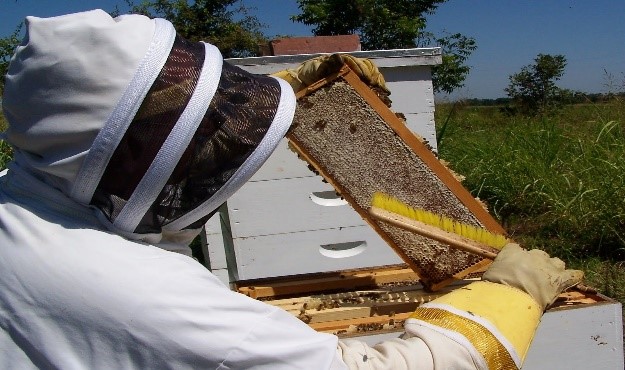Honey
Harvesting
 Have a bee suit, smoker, bee brush, hive tool and pail ready when preparing to harvest honey.
Have a bee suit, smoker, bee brush, hive tool and pail ready when preparing to harvest honey.- Honey is ready after 5 to 9 months from colonization depending on climate, vegetation and pest infestation.
- Honey is ripe when combs are sealed. Sealed honey has 17 % water content and will not ferment.
- Harvest honey when 8 or more combs have sealed honey. Any comb with honey and brood mixture should not be harvested.
- Harvest by cutting the honey comb off the top bar. Put the comb in a plastic or stainless steel bucket or pail and close tightly to prevent other bees from feeding on the honey.
- Honey is the bees' food. Leave enough combs for bees to feed on.
- Harvesting may be done up to 3 times a year. Average yields vary from 15 to 35kg per colony per harvest
5.1. Other hive products
Other hive products are bees-wax, pollen, bee brood, propolis and royal jelly, honey and beeswax being the major products.
After harvesting:
- Take out old, empty combs;
- Rearrange the remaining combs so there are no gaps between combs;
- Leave some honey for the bees;
- Feed the bees if possible or necessary. 5.2. PROCESSING
5.2.1. Honey
 Cut the combs into small pieces and strain the honey through a coarse strainer, screen wire or nylon cloth.
Cut the combs into small pieces and strain the honey through a coarse strainer, screen wire or nylon cloth.- Strain the honey through a fine strainer and leave the strained honey in a clean container such as pail for 3 to 5 days to settle. Then bottle the honey and close tightly ready for sale.
 5.2.1. Bees-wax
5.2.1. Bees-wax
- When processing wax, put the empty combs in a pot of water and heat the water till the wax melts
- The water should not boil. Strain the wax through a screen into a soap rubbed container and leave the wax there till it hardens then remove it and scrape debris off the bottom.
